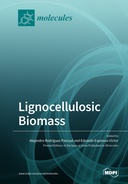Explore

Lignocellulosic Biomass
0 Ungluers have
Faved this Work
Login to Fave
Recently, there has been a growing awareness of the need to make better use of natural resources. Hence, the utilization of biomass has led to so-called biorefinery, consisting of the fractionation or separation of the different components of the lignocellulosic materials in order to achieve a total utilization of the same, and not only of the cellulosic fraction for paper production. The use of plant biomass as a basic raw material implies a shift from an economy based on the exploitation of non-renewable fossil fuels, with limited reserves or with regeneration cycles far below the rates of exploitation, to a bioeconomy based on the use of renewable organic natural resources, with balanced regeneration and extraction cycles. To make this change, profound readjustments in existing technologies are necessary, as well as the application of new approaches in research, development, and production."Biorefinery" is the term used to describe the technology for the fractionation of plant biomass into energy, chemicals, and consumer goods. The future generation of biorefinery will include treatments, leading to high-value-added compounds. The use of green chemistry technologies and principles in biorefineries, such as solvent and reagent recovery and the minimization of effluent and gas emissions, is essential to define an economically and environmentally sustainable process.In particular, the biorefinery of lignocellulosic materials to produce biofuels, chemicals and materials is presented as a solid alternative to the current petrochemical platform and a possible solution to the accumulation of greenhouse gases.
This book is included in DOAB.
Why read this book? Have your say.
You must be logged in to comment.
Rights Information
Are you the author or publisher of this work? If so, you can claim it as yours by registering as an Unglue.it rights holder.Downloads
This work has been downloaded 91 times via unglue.it ebook links.
- 91 - pdf (CC BY) at Unglue.it.
Keywords
- 29Si NMR
- 3D printing
- adsorbent material
- aerated bioreactor
- agiculture
- Agro-industry
- aromatics
- Aspergillus oryzae
- banana
- barley straw
- bio-based filament
- biobased
- biobased materials
- biobased polyethylene
- biofuel
- Biomass
- Biomaterials
- biopolymers
- biorefinery
- biorenewable
- biosurfactants
- carbohydrate
- Cellulose
- composite
- copper adsorption
- cryogels
- dialdehyde cellulose
- electro-oxidation
- electroreduction
- electrosynthesis
- energy crops
- enzymatic hydrolysis
- enzymatic saccharification
- epoxy
- fatty acid
- Fermentation
- Films
- flexural strength
- formaldehyde adhesives
- furfural
- H2S adsorption
- H2S removal
- high-value products
- horticultural residues
- iron chloride
- Jerusalem artichoke
- kraft lignin
- lignin
- lignocellulose
- lignocellulose nanofibers
- lignocellulose valorization
- lignocellulosic biomass
- lignocellulosic material
- micro-fibrillated cellulose
- microwave reactor
- n/a
- nanocellulose
- organosilane chemistry
- Paperboard
- quinoa saponins
- recycling
- reductive catalytic fractionation
- Reference, information & interdisciplinary subjects
- Research & information: general
- residue
- saccharides
- silanization
- solid state NMR
- solid-state fermentation
- steam-pretreated spruce
- sugarcane bagasse pulp
- thema EDItEUR::G Reference, Information and Interdisciplinary subjects::GP Research and information: general
- torrefaction
- wood-based panels
- xylose
- β-cyclodextrin
- ‘lignin-first’
Links
DOI: 10.3390/books978-3-0365-2474-0Editions

